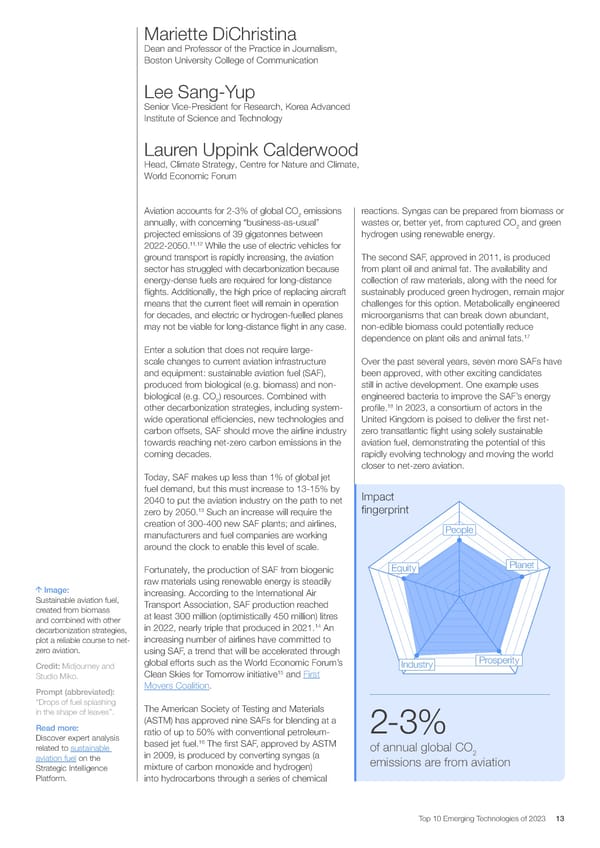Mariette DiChristina Dean and Professor of the Practice in Journalism, Boston University College of Communication Lee Sang-Yup Senior Vice-President for Research, Korea Advanced Institute of Science and Technology Lauren Uppink Calderwood Head, Climate Strategy, Centre for Nature and Climate, World Economic Forum Aviation accounts for 2-3% of global CO emissions reactions. Syngas can be prepared from biomass or 2 annually, with concerning “business-as-usual” wastes or, better yet, from captured CO and green 2 projected emissions of 39 gigatonnes between hydrogen using renewable energy. 11,12 2022-2050. While the use of electric vehicles for ground transport is rapidly increasing, the aviation The second SAF, approved in 2011, is produced sector has struggled with decarbonization because from plant oil and animal fat. The availability and energy-dense fuels are required for long-distance collection of raw materials, along with the need for 昀氀ights. Additionally, the high price of replacing aircraft sustainably produced green hydrogen, remain major means that the current 昀氀eet will remain in operation challenges for this option. Metabolically engineered for decades, and electric or hydrogen-fuelled planes microorganisms that can break down abundant, may not be viable for long-distance 昀氀ight in any case. non-edible biomass could potentially reduce dependence on plant oils and animal fats.17 Enter a solution that does not require large- scale changes to current aviation infrastructure Over the past several years, seven more SAFs have and equipment: sustainable aviation fuel (SAF), been approved, with other exciting candidates produced from biological (e.g. biomass) and non- still in active development. One example uses biological (e.g. CO ) resources. Combined with engineered bacteria to improve the SAF’s energy 2 other decarbonization strategies, including system- 18 In 2023, a consortium of actors in the pro昀椀le. wide operational ef昀椀ciencies, new technologies and United Kingdom is poised to deliver the 昀椀rst net- carbon offsets, SAF should move the airline industry zero transatlantic 昀氀ight using solely sustainable towards reaching net-zero carbon emissions in the aviation fuel, demonstrating the potential of this coming decades. rapidly evolving technology and moving the world closer to net-zero aviation. Today, SAF makes up less than 1% of global jet fuel demand, but this must increase to 13-15% by Impact 2040 to put the aviation industry on the path to net 13 Such an increase will require the 昀椀ngerprint zero by 2050. creation of 300-400 new SAF plants; and airlines, People manufacturers and fuel companies are working around the clock to enable this level of scale. Fortunately, the production of SAF from biogenic Equity Planet raw materials using renewable energy is steadily Image: increasing. According to the International Air Sustainable aviation fuel, Transport Association, SAF production reached created from biomass at least 300 million (optimistically 450 million) litres and combined with other 14 An decarbonization strategies, in 2022, nearly triple that produced in 2021. plot a reliable course to net- increasing number of airlines have committed to zero aviation. using SAF, a trend that will be accelerated through Credit: Midjourney and global efforts such as the World Economic Forum’s Industry Prosperity 15 Studio Miko. Clean Skies for Tomorrow initiative and First Prompt (abbreviated): Movers Coalition. “Drops of fuel splashing The American Society of Testing and Materials in the shape of leaves”. (ASTM) has approved nine SAFs for blending at a Read more: ratio of up to 50% with conventional petroleum- 2-3% Discover expert analysis 16 The 昀椀rst SAF, approved by ASTM related to sustainable based jet fuel. of annual global CO aviation fuel on the in 2009, is produced by converting syngas (a 2 Strategic Intelligence mixture of carbon monoxide and hydrogen) emissions are from aviation Platform. into hydrocarbons through a series of chemical Top 10 Emerging Technologies of 2023 13
 Top 10 Emerging Technologies of 2023 Page 12 Page 14
Top 10 Emerging Technologies of 2023 Page 12 Page 14